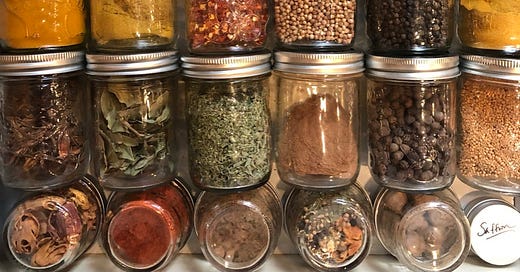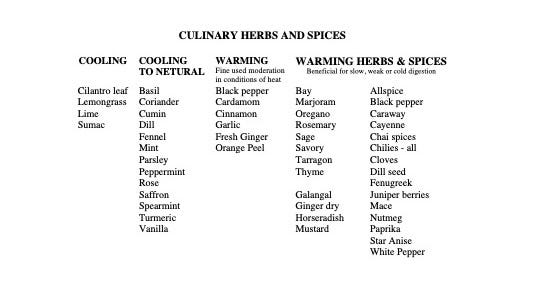You can access a recording of this post here
This is part two of a two part series on Culinary Herbs and Spices. In part one I share with you my own journey into the world of culinary herbs and spices and share with you the benefits of including more of them in your diet. You can access part one here.
HOW TO INTEGRATE MORE HERBS AND SPICES INTO YOUR COOKING
The benefits of including more culinary and herbs and spices in our diet are broad. Not only making food taste good, but strengthening our digestive fire - making us better able to digest and assimilate the foods that we eat. Culinary herbs and spices can also have a significant impact on our body’s energetics. Much of Ayurveda is based on a deep appreciation for these energetic properties of culinary herbs and spices that come to us mainly through the flavours.
THE MAIN FLAVOURS OR TASTES
When we think about making food “taste good”, it’s usually a combination of the following flavours that are part of that experience of good taste. Good health depends on a balance of these flavours acting in a way that is harmonious to the unique energetics of our body. Let’s look at these flavours in a bit more detail so that we can better understand how to work with them in the foods that we eat.
Sweet - The sweet flavours most often come to us through the foods themselves. This is one of the overused flavours in the processed food industry. This overuse taints our taste buds making it difficult for us to appreciate the subtle sweet flavours of grains, root vegetables and fresh fruit. This subtle “sweet” quality is a flavour associated with nourishing and building, which is why it is an important flavour especially for children and those that are undernourished and deficient. Children will naturally gravitate to these sorts of flavours so direct their taste buds towards the whole foods versions including cooked grains, root vegetables and fresh fruits.
Sour or Tangy flavours can be found in pickled foods, sauerkraut, vinegar, lemon, mild salsa, tamarind, sumac. Ever notice how some people just crave pickles? Give each unique body type the option to satisfy its needs for certain flavours in the healthiest ways possible. These flavours can help balance a person’s underlying energetics.
Salt can be another overused flavour in the food processing industry. However salt is important for good health. A small proportion of the population is salt sensitive and needs to be mindful of reducing salt intake. When we switch over to a more whole foods diet, it is fine for most people to add salt. In addition to table salt, sea salt, Redmond salt or Himalayan salt, think of sea vegetables such as kelp, various fermented foods including miso, and variations on soy sauce such as coconut aminos. Consider also variations on seasoning salts made with healthy ingredients.
Umami is an important contributor that can give a depth and satisfaction to the overall flavour of a dish. To get a sense of the umami flavour think mushrooms, marmite, nutritional yeast, sun dried tomatoes and tomato paste, cured olives, aged cheese. Many umami flavours are also salty such as kelp and other sea vegetables, miso, fish sauce, shrimp paste, anchovies, bacon and other smoked meats, soy sauce or coconut aminos.
Bitter flavour most often comes to us through our vegetables especially the leafy greens and cabbage family vegetables. It is also found in turmeric. Bitter is a flavour that stimulates the liver and digestion making it a beneficial flavour to include in our meals. The use of traditional “digestive bitters” can also serve this function.
Hot, Pungent and Aromatic flavours
The hot, pungent and aromatic flavours cover many of the common culinary herbs and spices. I break down this category further into these subcategories in order to understand their use more clearly.
Primarily Hot- I put chilies and cayenne in a category of their own. While we may think of all spicy foods as being “hot”, the most intense heat usually comes from the chilies, hot peppers and cayenne. This kind of heat can be problematic for some body types and beneficial to others. When you season your foods or make your own spice blends you can reduce or omit the chilies to make the dish more neutral to the rest of your family members. Extra heat can easily be added to a dish at the table.
Hot and Pungent flavours include black pepper, mustard, garlic, ginger, horseradish, wasabi
Warming pungent and aromatic spices often called “carminatives” are classically used to stimulate digestion. The classics here include fennel, anise, caraway, cumin, coriander, dill seed, fenugreek. Some of these warming pungent spices are more sweet in flavour and often familiar to us in chai tea and baked desserts such as allspice, cardamom, cinnamon, cloves, mace, nutmeg, orange peel, star anise
Warming aromatic herbs including rosemary, thyme, oregano, marjoram, sage often have a carminative effect as well
Cooling aromatic herbs include cilantro, fresh dill and mint
THE BOTTOM LINE - START SIMPLE
Start simple. When faced with a new recipe that calls for herbs or spices you don’t have on hand, don’t ditch the recipe. Instead, improvise with flavours and seasonings that you love and have on hand. You may want to focus on cooking fairly mildly tasting family meals and offering extra seasonings on the side. Create a kitchen table flavour collection that includes something from each of the following taste categories, allowing family members to pick and choose according to their taste buds.
Sour - Include some pickles or other fermented foods at each meal. Hold the ketchup and offer a mild salsa, apple cider vinegar, or a homemade dressing featuring lemon or vinegar
Salty - Herbamare or some other herbal seasoning salt, sea salt, kelp etc
Umami - Porcini mushroom powder is easy to make and works well sprinkled on food. I’ve seen dried porcini mushrooms in the Italian food section of grocery stores.
Hot sauce of your choice, or spice mixture high on the chilies or cayenne
A carminative spice blend that includes some of the warming pungent aromatic spices listed above - without the cayenne or chilies - or at least very little. You want it to appeal to those taste buds that don’t necessarily like heat. So if you choose curry powder as an option, choose a very mild one. Many of the well known spice blends of the world include these flavours, not just curry powder. Explore. Try something new. A traditional Ayurvedic blend to support digestion is made up of equal parts of cumin, coriander and fennel seed. These can be nice in combo, but also great as individual flavours.
A sweet warming spice blend reminiscent of pumpkin pie spice, chai spices, British mixed spice, Chinese five spice or the French quatre epices - think cinnamon, ginger, nutmeg, clove etc
An herbal blend that you enjoy, such as Italian Seasoning, Greek Seasoning or Herbes de Provence
If you’ve got a lot of heat, you might enjoy some cooling foods and herbs at the meal such as cilantro, mint, dill or cucumber. This might take the form of a few slices of cucumber or a handful of herbs added as a garnish to the meal, in a salad, or in the form of a green sauce. Think also of the Greek Tzatziki or an Indian Raita. Keep in mind that not everyone likes cilantro. If a recipe calls for it, I find it might be better to serve alongside as an optional garnish or green sauce versus mixed in. We want to increase the likelihood that the whole family will enjoy the meal.
Bitter can also be helpful for people with excess heat or those needing more liver and digestive support. Children often balk at this flavour. Bitter flavours include the cabbage family vegetables, artichokes, and various greens such as endives, arugula, dandelion greens etc. Bitters can also take the form of an herbal bitters taken before or after the meal to support digestion.
EXPLORE AND EXPAND YOUR TASTE BUD HORIZONS
For those of you that are feeling more adventurous, consider the many complex tastes and flavours of the world. Where to begin? Look at the spices used in the cuisines that you most enjoy or are intrigued by. Is it Italian, Mexican, Indian, Moroccan, Middle Eastern, Greek, Spanish, Thai, Chinese? You might start by purchasing quality spice blends of the particular cuisine you are most drawn to.
While many of these blends can be purchased ready made, there is something exhilarating about freshly grinding whole spices to make your own. Consider investing in a coffee grinder geared only to grinding spices and purchase the individual spices to make your own version of the blend. I would recommend purchasing them whole. In their whole seed form, they will hold their flavour for quite a few years, so they do keep pretty well. You can then grind them fresh as needed.
Dried herbs don’t have the same shelf life as spices, which is why I love to grow them myself when possible. They can be easily dried for the upcoming winter’s use. They are of course fine to purchase dry. Experiment - you will find your home grown herbs will have so much more flavour than commercially available dried herbs, most of which have been sitting around for a few years before they got to your kitchen. If you know of any particularly good sources for spices and vibrant dried culinary herbs let me know. Over the years I have found some of the freshest dried herbs and spices in Middle Eastern grocery stores and other ethnic markets.
Over time, you will create your own collection of dried herbs and spices. Eventually you will find that the spice blends of other cuisines that you come across are often some variation of these basic herbs and spices that you will already have on hand.
I share with you a chart that lists the common culinary herbs and spices according to their energetics. Over time, I will share more posts about energetics so that you can begin to understand how to best support your body’s unique patterns. Many of these herbs and spices can also be added to herbal tea blends, depending on what works for your taste buds. And I’m not just talking chai tea. You won’t know until you’ve tried it ;)





